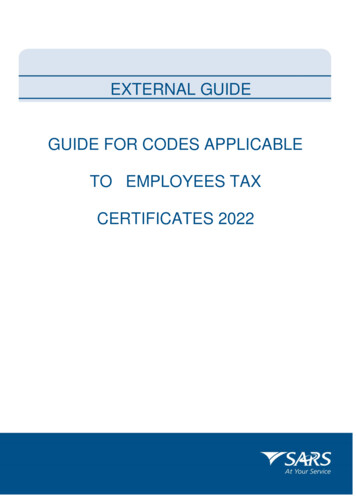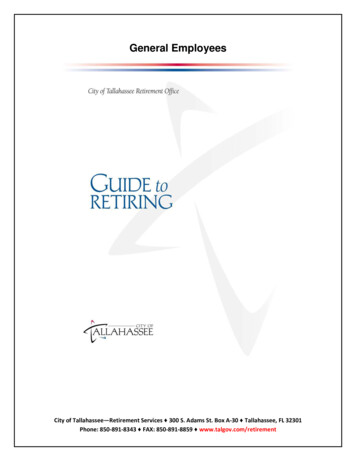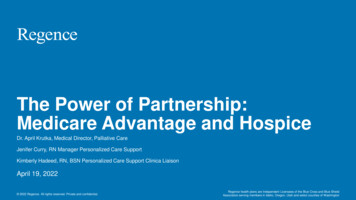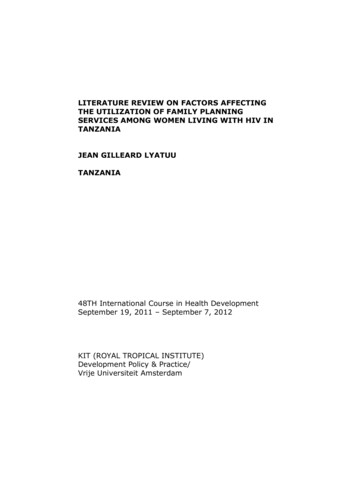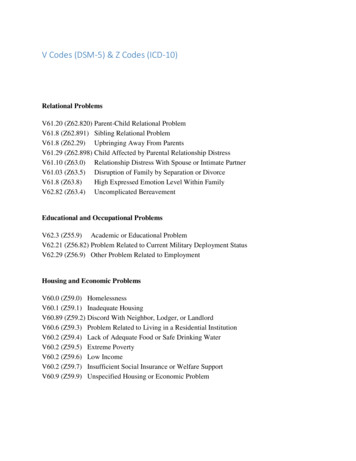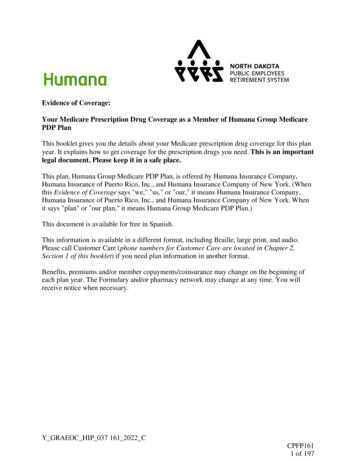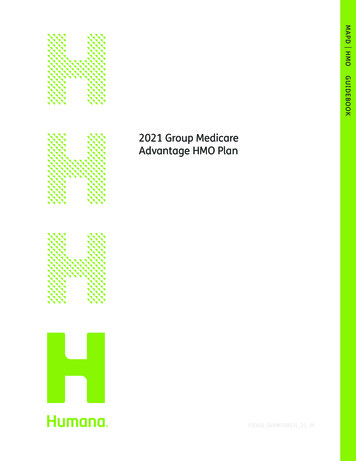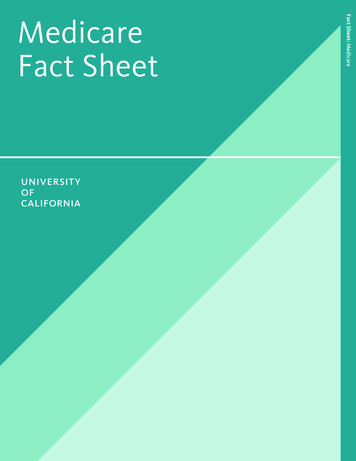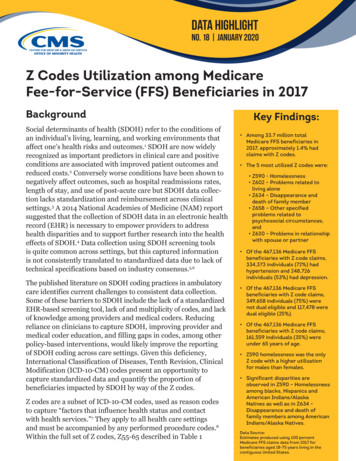
Transcription
DATA HIGHLIGHTNO. 18 JANUARY 2020Z Codes Utilization among MedicareFee-for-Service (FFS) Beneficiaries in 2017BackgroundSocial determinants of health (SDOH) refer to the conditions ofan individual’s living, learning, and working environments thataffect one’s health risks and outcomes.1 SDOH are now widelyrecognized as important predictors in clinical care and positiveconditions are associated with improved patient outcomes andreduced costs.2 Conversely worse conditions have been shown tonegatively affect outcomes, such as hospital readmissions rates,length of stay, and use of post-acute care but SDOH data collection lacks standardization and reimbursement across clinicalsettings.3 A 2014 National Academies of Medicine (NAM) reportsuggested that the collection of SDOH data in an electronic healthrecord (EHR) is necessary to empower providers to addresshealth disparities and to support further research into the healtheffects of SDOH.4 Data collection using SDOH screening toolsis quite common across settings, but this captured informationis not consistently translated to standardized data due to lack oftechnical specifications based on industry consensus.5,6The published literature on SDOH coding practices in ambulatorycare identifies current challenges to consistent data collection.Some of these barriers to SDOH include the lack of a standardizedEHR-based screening tool, lack of and multiplicity of codes, and lackof knowledge among providers and medical coders. Reducingreliance on clinicians to capture SDOH, improving provider andmedical coder education, and filling gaps in codes, among otherpolicy-based interventions, would likely improve the reportingof SDOH coding across care settings. Given this deficiency,International Classification of Diseases, Tenth Revision, ClinicalModification (ICD-10-CM) codes present an opportunity tocapture standardized data and quantify the proportion ofbeneficiaries impacted by SDOH by way of the Z codes.Z codes are a subset of ICD-10-CM codes, used as reason codesto capture “factors that influence health status and contactwith health services.”7 They apply to all health care settingsand must be accompanied by any performed procedure codes.8Within the full set of Z codes, Z55-65 described in Table 1Key Findings: Among 33.7 million totalMedicare FFS beneficiaries in2017, approximately 1.4% hadclaims with Z codes. The 5 most utilized Z codes were: Z590 - Homelessness Z602 – Problems related toliving alone Z634 – Disappearance anddeath of family member Z658 – Other specifiedproblems related topsychosocial circumstances,and Z630 – Problems in relationshipwith spouse or partner Of the 467,136 Medicare FFSbeneficiaries with Z code claims,334,373 individuals (72%) hadhypertension and 248,726individuals (53%) had depression. Of the 467,136 Medicare FFSbeneficiaries with Z code claims,349,658 individuals (75%) werenot dual eligible and 117,478 weredual eligible (25%). Of the 467,136 Medicare FFSbeneficiaries with Z code claims,161,559 individuals (35%) wereunder 65 years of age. Z590 homelessness was the onlyZ code with a higher utilizationfor males than females. Significant disparities areobserved in Z590 – Homelessnessamong blacks, Hispanics andAmerican Indians/AlaskaNatives as well as in Z634 –Disappearance and death offamily members among AmericanIndians/Alaska Natives.Data Source:Estimates produced using 100 percentMedicare FFS claims data from 2017 forbeneficiaries aged 18-75 years living in thecontiguous United States.
specifically assess SDOH by identifying individuals with potentially hazardous socioeconomic andpsychosocial circumstances.8 Throughout the remaining figures and text of this report, Z codeswill refer specifically to this category of SDOH-associated Z codes. As shown in Table 1, there arenine categories of Z codes related to SDOH and several sub-codes, comprising a total of 97 granularcodes.9 For example, Z55 (problems related to education and literacy) is further broken out into sevensub-codes including: Z55.0 Illiteracy and low-level literacy Z55.1 Schooling unavailable or unattainable Z55.2 Failed school examinations Z55.3 Underachievement in school Z55.4 Educational maladjustment and discord with teachers and classmates Z55.8 Other problems related to education and literacy Z55.9 Problems related to education and literacy, unspecifiedIn light of the growing awareness of the importance of SDOH in patient health outcomes, and theneed for the collection and documentation of this data in clinical settings to improve patient care,this study analyzes the utilization of Z codes in 2016 and 2017 among Medicare fee-for-services (FFS)beneficiaries. Z codes did not exist prior to implementation of the ICD-10-CM codes in 2015. Theirprecursors were V codes, which are described in the ICD-9-CM chapter “Supplementary Classificationof Factors Influencing Health Status and Contact with Health Services.” The new more expanded Zcodes were first available in 2016 Medicare claims.The unique beneficiary count for Z code utilization was 446,171 in 2016. In 2017, the beneficiarycount increased by 4.69% to 467,136, thus representing 1.4 percent of 33.7 million total beneficiariesin CY2017. While 2016 Medicare FFS claims data was analyzed, this data highlight only presents themore recent 2017 data, due to this marginal increase in Z code utilization. This study first uses claimcounts to identify the top five most utilized Z codes in 2017. It then presents unique beneficiary countsfor all SDOH Z codes and these five specific Z codes across various demographic characteristics,including chronic conditions, dual eligibility under Medicare and Medicaid, age, sex and race.Table 1. Z Codes and Sub-Codes Related to Social Determinants of HealthDATA HIGHLIGHT JANUARY 2020Paid for by the U.S. Department of Health and Human Services.2
MethodsThe data source for this study is Medicare claims and enrollment data obtained from the CMS ChronicCondition Data Warehouse (CCW) (www.ccwdata.org). Within the CCW environment, SAS EnterpriseGuide (V.9.4; SAS, Cary, NC) was used to produce utilization and beneficiary statistics. Specifically,we used complete (100 percent) FFS claims data in the Geographic Variation Database (GVDB), whichcovers both Medicare Part A inpatient hospital care, post-acute care (such as skilled nursing facilitycare and home health) and hospice care, and Medicare Part B, which primarily covers physicianservices, outpatient hospital care, and durable medical equipment, to identify beneficiaries with ICD10 diagnosis codes within the Z55-65 set related to socioeconomic and psychosocial circumstances,capturing information on SDOH. The CCW contains a unique beneficiary identifier that was used tolink claims with individual level beneficiary files containing demographic, enrollment and chroniccondition data. The files used were for calendar years 2016 and 2017.DATA HIGHLIGHT JANUARY 2020Paid for by the U.S. Department of Health and Human Services.3
ResultsFigure 1. Medicare FFS Diagnosis Code Counts for Top 5 Z Codes in 2017Among Medicare FFS beneficiaries in 2017, the top 5 most utilized Z codes were: Homelessness (Z590) – 223,062 claims Problems related to living alone (Z602) – 196,551 claims Disappearance and death of family member (Z634) – 127,766 claims Other specified problems related to psychosocial circumstances (Z658) – 58,083 claims Problems in relationship with spouse or partner (Z630) – 49,448 claimsDATA HIGHLIGHT JANUARY 2020Paid for by the U.S. Department of Health and Human Services.4
Figure 2. Top 10 Chronic Conditions among Medicare FFS Beneficiaries with Z Codes in 2017Among the 33.7 million total Medicare FFS beneficiaries in 2017, the top 10 chronic conditions were: Hypertension (57%) Hyperlipidemia (41%) Rheumatoid Arthritis/Osteoarthritis (33%) Diabetes (27%) Ischemic Heart Disease (27%) Chronic Kidney Disease (24%) Depression (18%) Congestive Heart Failure (14%) Chronic Obstructive Pulmonary Disease (12%) Alzheimer’s Disease/Dementia (11%)DATA HIGHLIGHT JANUARY 2020Paid for by the U.S. Department of Health and Human Services.5
Among the 467,136 Medicare FFS beneficiaries with Z code claims in 2017, the top 10 chronicconditions were: Hypertension (72%) Depression (53%) Hyperlipidemia (48%) Rheumatoid Arthritis/Osteoarthritis (45%) Chronic Kidney Disease (38%) Anemia (38% ) Ischemic Heart Disease (36%) Diabetes (34%) Chronic Obstructive Pulmonary Disease (25%) Congestive Heart Failure (25%)Many beneficiaries have more than one chronic condition.Figure 3. Dual Status Distribution among Medicare FFS Beneficiaries with Top 5 Z Codes in 2017DATA HIGHLIGHT JANUARY 2020Paid for by the U.S. Department of Health and Human Services.6
In this study, dual status refers to beneficiaries who were eligible for both Medicare and Medicaidduring the entire calendar year. Of the 33.7 million total Medicare FFS beneficiaries in 2017, 3.9million (11.7 percent) were dual eligible and 29.8 million (88.3 percent) were not dual eligible. Therewere more non-dual beneficiaries than dual beneficiaries across the Z codes. The most noteworthyfindings are restated below.Of the 467,136 Medicare FFS beneficiaries with Z code claims: 117,478 were dual eligible (25%) 349,658 beneficiaries were not dual eligible (75%)Of the 122,011 Medicare FFS beneficiaries with Z602 problems related to living alone: 19,190 beneficiaries were dual eligible (16%) 102,821 beneficiaries were not dual eligible (84%)Of the 58,946 Medicare FFS beneficiaries with Z634 disappearance and death of a family member: 9,911 beneficiaries were dual eligible (17%) 49,035 beneficiaries were not dual eligible (83%)Of the 23,835 Medicare FFS beneficiaries with Z658 other specified problems related to psychosocialcircumstances: 6,736 were dual eligible (28%) 17,099 were not dual eligible (72%)Of the 15,108 Medicare FFS beneficiaries with Z630 problems in relationship with spouse or partner: 2,576 beneficiaries were dual eligible (17%) 12,532 beneficiaries were not dual eligible (83%)DATA HIGHLIGHT JANUARY 2020Paid for by the U.S. Department of Health and Human Services.7
Figure 4. Age Distribution among Medicare FFS Beneficiaries with Top 5 Z codes in 2017Of the 33.7 million total Medicare FFS beneficiaries in 2017: 5.3 million beneficiaries were under 65 (16%) 15.3 million beneficiaries were between 65 and 74 (45%) 8.7 million beneficiaries were between 75 and 84 (26%) 4.4 million beneficiaries were over 85 (13%)Of the 467,136 Medicare FFS beneficiaries with Z codes in 2017: 161,559 beneficiaries were under 65 (35%) 133,455 beneficiaries were between 65 and 74 (28%) 97,562 beneficiaries were between 75 and 84 (21%) 74,560 beneficiaries were over 85 (16%)While the general relationship between Z code usage and age was inverse, problems related to livingalone was the one exception. Among the 122,011 Medicare FFS beneficiaries with Z602 in 2017: 13,921 beneficiaries were under 65 (11%) 28,480 beneficiaries were between 65 and 74 (23%) 36,940 beneficiaries were between 75 and 84 (30%) 42,670 beneficiaries were over 85 (36%)DATA HIGHLIGHT JANUARY 2020Paid for by the U.S. Department of Health and Human Services.8
Figure 5. Sex Distribution among Medicare FFS Beneficiaries with Top 5 Z Codes in 2017Of the 33.7 million total Medicare FFS beneficiaries in 2017, 18.5 million (55%) were female and 15.2million (45%) were male. Of the 467,136 Medicare FFS beneficiaries with Z codes in 2017, 281,517(60%) were females and 185,619 (40%) were males. Below are the sex distributions for each of thetop 5 Z codes. Homelessness was the only Z code with a higher utilization for males than females. Themost noteworthy findings are stated below.Of the 73,900 Medicare FFS beneficiaries with Z590 homelessness: 24,186 beneficiaries were female (33%) 49,714 beneficiaries were male (67%)Of the 122,011 Medicare FFS beneficiaries with Z602 problems related to living alone: 84,783 beneficiaries were female (69%) 37,228 beneficiaries were male (31%)Of the 58,946 Medicare FFS beneficiaries with Z634 disappearance and death of a family member: 43,649 beneficiaries were female (74%) 15,297 beneficiaries were male (26%)DATA HIGHLIGHT JANUARY 2020Paid for by the U.S. Department of Health and Human Services.9
Figure 6. Race and Ethnicity Proportions among Medicare FFS Beneficiaries with Top 5 Z Codesin 2017Of the 33.7 million total Medicare FFS beneficiaries in 2017: 26.8 million beneficiaries were white (80%) 31.3 million beneficiaries were black (9%) 1.9 million beneficiaries were Hispanic (6%) 852,817 beneficiaries were Asian/Pacific Islander (API) (3%) 194,754 beneficiaries were American Indian/Alaska Native (AI/AN) (1%)Of the 467,136 Medicare FFS beneficiaries with Z codes in 2017: 353,885 beneficiaries were white (76%) 62,569 beneficiaries were black (13%) 31,526 beneficiaries were Hispanic (1%) 7,213 beneficiaries were API ( 1%) 5,055 beneficiaries were AI/AN ( 1%)Although the representation of the minority groups in the top five Z codes is relatively low comparedto the overall Medicare FFS population, with the exception of blacks, the rates were highest for AI/AN and lowest for APIs. Significant disparities are observed in Z590 homelessness among blacks,Hispanics, and AI/ANs, as well as in Z634 disappearance and death of family members among AI/ANs. The proportion of black and AI/ANs with homelessness was more than three times higher thannon-Hispanic white beneficiaries.DATA HIGHLIGHT JANUARY 2020Paid for by the U.S. Department of Health and Human Services.10
ConclusionThis study represents the first analysis of Medicare FFS claims data for the utilization of Z codes.It identified 467,136 unique Medicare FFS beneficiaries with Z code claims in 2017, representingonly 1.4 percent of the total FFS population. Among the claims identified, the five most utilized Zcodes (Figure 1) are homelessness, problems related to living alone, disappearance and death offamily member, other specified problems related to psychosocial circumstances, and problems inrelationship with spouse or partner.The findings of this study may represent an undercount of assessments of the patient social needs. Arecent study found that 24% of hospitals and 16% of physician practices screened for food insecurity,housing instability, utilities, transportation, and interpersonal violence.10 While more screening mayoccur, it is less clear to what extent the needs are being documented and shared among providers.Social determinants of health are associated with patient outcomes like hospital readmission ratesand cost of care, and is the subject of growing interest among providers, health plans, payers, andcommunity based organizations throughout the health system. SDOH data collection can lead to anincrease in patient referrals to supportive services, and help identify population-level trends thathave both health and cost implications.11,12A number of challenges and potential solutions exist to increase the recording of SDOH with Z codes.In addition to this quantitative study, CMS held a listening session with interdisciplinary expertsincluding health plans, EHR vendors, and providers to gain a better understanding of the factorsthat contribute to low utilization. Participants noted a general lack of awareness of the Z codes,and confusion as to who could document social needs. Several participants were unaware that theFY 2019 ICD-10-CM Official Guidelines for Coding and Reporting stated that clinicians other thanthe patient’s provider could document social determinants of health. This would include but not belimited to nurses, social workers, psychologists, and dieticians. These guidelines were approved bythe American Hospital Association, the American Health Information Management Association,CMS, and National Center for Health Statistics.8This data highlight provides insight into the limited documentation of social determinants of healthfor Medicare FFS beneficiaries. However, more widely adopted and consistent documentation isneeded to more comprehensively identify social needs, and monitor progress in addressing them.Collaboration between beneficiaries, community groups, and health care providers will be necessaryto adequately address the social determinants of health, and ultimately to improve health outcomes.DATA HIGHLIGHT JANUARY 2020Paid for by the U.S. Department of Health and Human Services.11
References1. Centers for Disease Control and Prevention. Social Determinants of terminants-of-health.pdf2. Olson DP, Oldfield BJ, Navarro SM. Standardizing Social Determinants Of Health Assessments.Health Affairs Blog. doi:10.1377/hblog20190311.8231163. Torres JM, Lawlor J, Colvin JD, et al. ICD Social Codes: An underutilized resource for trackingsocial needs. Med Care. 2017;55(9):810-816. doi:10.1097/MLR.00000000000007644. Institute of Medicine of the National Academies. Capturing social and behavioral domains inelectronic health records: Phase 1 (2014). Washington (DC); 2014.5. Committee on Accounting for Socioeconomic Status in Medicare Payment Programs. Accountingfor Social Risk Factors in Medicare Payment. Washington, DC: National Academies of Sciences,Engineering, and Medicine; 2016.6. Gottlieb L, Tobey R, Cantor J, et al. Integrating social and medical data to improve populationhealth: opportunities And barriers. Health Affairs (Millwood). 2016 Nov 1;35(11):2116-2123.7. ICD-10-CM Codes. Factors influencing health status and contact with health 00-Z998. ICD-10-CM Official Guidelines for Coding and Reporting FY 2019. (October 1, 2018 - September30, 2019). s/2019-ICD10-CodingGuidelines-.pdf9. ICD-10-CM Codes. 5-Z6510. Fraze TK, Brewster AL, and Lewis VA. Prevalence of Screening for Food Insecurity,Housing Instability, Utility Needs, Transportation Needs, and Interpersonal Violence byUS Physician Practices and Hospitals. JAMA Netw Open. 2019;2(9):e1911514. doi:10.1001/jamanetworkopen.2019.11514.11. Olson DP, Oldfield BJ, Navarro SM. Standardizing Social Determinants Of Health Assessments.Health Affairs Blog. doi:10.1377/hblog20190311.82311612. Torres JM, Lawlor J, Colvin JD, et al. ICD Social Codes: An underutilized resource for trackingsocial needs. Med Care. 2017;55(9):810-816. doi:10.1097/MLR.0000000000000764DATA HIGHLIGHT JANUARY 2020Paid for by the U.S. Department of Health and Human Services.12
About the AuthorsCarla Hodge and Meagan Khau are with the Centers for Medicare & Medicaid Services Office ofMinority Health. James Mathew was an intern with the Centers for Medicare & Medicaid ServicesOffice of Minority Health.Suggested CitationMathew, J, Hodge, C, and Khau, M. Z Codes Utilization among Medicare Fee-for-Service (FFS)Beneficiaries in 2017. CMS OMH Data Highlight No. 17. Baltimore, MD: CMS Office of MinorityHealth. 2020.DisclaimerThis work was sponsored by the Centers for Medicare & Medicaid Services Office of Minority Health.CMS Office of Minority Health7500 Security Blvd.MS S2-12-17Baltimore, MD 21244Phone: 410-786-6812Fax: 410-786-0634http://go.cms.gov/cms-omhDATA HIGHLIGHT JANUARY 2020Paid for by the U.S. Department of Health and Human Services.13
Modification (ICD-10-CM) codes present an opportunity to capture standardized data and quantify the proportion of beneficiaries impacted by SDOH by way of the Z codes. Z codes are a subset of ICD-10-CM codes, used as reason codes . to capture "factors that influence health status and contact with health services." 7
